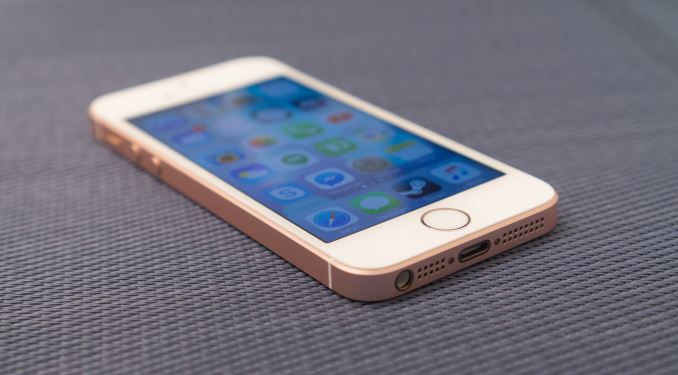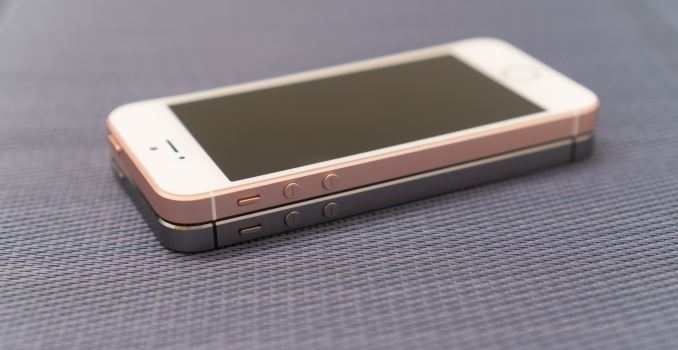The iPhone SE Review
by Brandon Chester on May 16, 2016 8:00 AM EST- Posted in
- Smartphones
- Apple
- Mobile
- iPhone
- iPhone SE
Final Words
It’s really not difficult to come to a conclusion on the iPhone SE. It’s clearly the best 4-inch smartphone on the market, and you can ignore all of the specs when making that assessment because it achieves that by virtue of being the only offering at this size. For the sake of comparison, you can take a look at some Android devices that are larger than the SE, but smaller than your average Android smartphone.
As I said earlier in the review, Android manufacturers have essentially given up on making small smartphones, and most of them haven’t actually made a top tier smartphone at the 4-inch size in about four years. By 2012 things had moved to 4.5 inches or more, with Samsung also introducing the original 5.3-inch Galaxy Note near the end of 2011. Today’s idea of a compact Android phone is something like the Xperia Z5 compact, where the screen has a size of 4.6 inches, which is just a bit smaller than the screen on the iPhone 6s. Getting an even smaller screen means moving to truly low end smartphones like the Moto E, and at that point you’re discussing two entirely different parts of the market.
Even when you consider the smallest high-end devices from the Android manufacturers, it’s not hard to see that the iPhone SE comes out on top. Apple’s A9 SoC is still one of the fastest chips you’ll find in a smartphone, and it goes without saying that the Snapdragon 810 SoC in a smartphone like the Xperia Z5 Compact really isn’t comparable in the slightest. Based on my experience, the camera is also unmatched at this size and price. It’s certainly a step behind the best Android phones and the iPhone 6s Plus, but bringing the sensor from the iPhone 6s to the SE allows for some really great photos, and the best 4K recording video you’ll get on a phone.
The 4-inch IPS display on the iPhone SE has great calibration, and in general the resolution is sufficient to avoid aliasing, although it’s obviously not as sharp as what you’ll get on many Android smartphones. My main complaint about the display is the low contrast ratio and high black level, which is definitely noticeable in real-world use when you compare to more modern LCD displays or any AMOLED panel. Apple definitely intends to keep this phone around for at least a couple of years, if not three, and it’s not going to take remotely that long for the SE’s display to fall quite a few steps behind the market. As far as future-proofing goes, the display is probably the iPhone SE’s one weak spot, although right now it’s still a nice IPS display.
Finally, we have the design of the phone. It’s really unchanged from the iPhone 5s, and some may consider that a bad thing, but I think it’s a good thing. The design still holds up, and there’s absolutely no reason to arbitrarily redesign a product every cycle. The products that are used as examples of good design are often ones that have kept the same design for many years, and in some cases many decades. I can definitely understand those who wanted a device that was more like a small iPhone 6s, but for me the aesthetics of the iPhone 5 era design come out ahead.
Ultimately, the iPhone SE is the upgrade that Apple’s 4-inch iPhone has needed for a while. Considering that it’s been over two years, it’d be hard to not improve, but the fact that you get the same performance, camera, and display calibration as the iPhone 6s is quite appealing when the phone costs $250 less. Battery life is better or worse than the 6s depending on the situation, but it’s definitely improved overall from the 5s. Faster LTE and much faster WiFi are nice improvements too, and you also have Apple Pay thrown in. There’s not much more than Apple could have included without further cutting into their margins and making it really hard to explain why the 6s is significantly more expensive. Even with the things you lose out on, I still find myself asking whether the 6s is truly worth that $250 premium.
While I’ve used the iPhone SE as my daily driver for a month, I expect that I’ll be going back to the Nexus 5X and iPhone 6s. The smaller display is just not for me, but when Apple can sell thirty million two-year-old 4-inch smartphones in a year there’s clearly demand for a smaller smartphone with high end specs. The iPhone SE delivers that, and I think users who have been holding on to an iPhone 5 or 5s should seriously consider it, because it’s the phone that they’ve been waiting for.












138 Comments
View All Comments
michael2k - Tuesday, May 17, 2016 - link
Why is that review a joke? Look at this review, with it's graphs! NAND, CPU, and GPU are essentially the same as the iPhone 6S, and the battery life is a little better.Eden-K121D - Tuesday, May 17, 2016 - link
LOLfm13 - Wednesday, May 18, 2016 - link
any plans to review Xiaomi Mi5?chris.london - Monday, May 16, 2016 - link
Could you please run a few storage benchmarks on the SE? I would love to see if Apple skimped on the storage or not.CloudWiz - Monday, May 16, 2016 - link
^ This please, I couldn't find any good storage benchmarks online about the SE. The storage is definitely faster than on my old iPhone 5, but I'm pretty sure it's not as great as the NVMe on the 6s. I wonder if they're using NVMe on this phone or something slower like on the 6.Brandon Chester - Monday, May 16, 2016 - link
We're a bit iffy on what to do about storage benchmarking going forward due to issues with the tools available on the Android side. I've updated page two with NAND results for anyone who is interested.CloudWiz - Wednesday, May 18, 2016 - link
Thanks so much Brandon! Wow, I did not expect them to use the same storage. Kudos to Apple for fitting so much of the latest and greatest while still keeping it cheap.leexgx - Tuesday, May 17, 2016 - link
hey really need to drop the 16GB model (32GB should be the min on a iphone)michael2k - Tuesday, May 17, 2016 - link
As the single largest buyer of NAND, doing so would cause a flash shortage and drive up prices everywhere, or force everyone else to use less storage. Essentially if you double from 16GB to 32GB you should expect NAND prices for 32GB parts to go up to $12 and the 16GB parts to drop below $2.Apple uses a single $8.4 256Gb NAND chip, to hit 32GB:
http://www.insye.com/DP/NANDFlashContractPrice.asp...
LauRoman - Monday, May 16, 2016 - link
http://anandtech.com/show/7335/the-iphone-5s-revie...